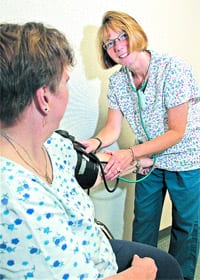Speed Bumps When to Seek Help When a Child Sustains a Head Injury
Winter has arrived, and for emergency-department physicians everywhere, that means a season filled with slips and spills on snowy and icy pavements and a host of injuries from winter activities that often result in bumps to the head.
For children and adolescents, head injuries are a common occurrence, yet most are mild and not associated with traumatic brain injury. But for some kids, a bump to the head can be more than just a sensitive memory of the fall they took out on the rink when learning how to ice skate. And that raises the question, when is it appropriate for a child to visit the emergency department after suffering a head injury?
Family and friends often ask me about what to do when one of their children hits their head. And even parents in our Pediatric Emergency Department at Baystate tell me they weren’t really sure whether or not to bring in their child.
What I normally tell them is that any youngster who’s not acting like himself or herself after hitting their head should talk to their doctor. In addition, parents should seek immediate medical attention for their child if they notice behavior changes such as irritability or drowsiness, or if their child develops a severe headache or recurrent vomiting.
For a child who resumes playing or running immediately following a bump on the head, life-threatening injury is unlikely because symptoms of a serious head injury usually appear immediately. However, symptoms can develop within the first few hours. For example, actress Natasha Richardson, on a skiing holiday not too long ago, died of a traumatic brain injury following a blunt impact to her head, but she did not have any symptoms until an hour after the accident.
If a child appears sleepy or confused after a head injury, it is important to have a physician determine if he or she has sustained a concussion or a more serious injury. The American Academy of Pediatrics recommends that parents contact their child’s health care provider for advice on any injury that is more than a light bump on the head.
The Radiation Question
Some parents are concerned over their child’s exposure to radiation when we tell them that he or she will need a CT (computed tomography) scan. Studies have shown that, all too often, youngsters with mild head trauma are unnecessarily exposed to radiation from a CT scan. There is also research showing that exposure to ionizing radiation increases the likelihood that a patient will develop cancer in the future. However, the risk is low for a single scan, especially if there is appropriate attention to dose reduction.
Hospitals owe it to their patients to take precautions to protect children and adults from overexposure to radiation from CT scans and other forms of imaging technology. At Baystate, our goal is to minimize exposure to the extent possible. Our Department of Radiology has taken its commitment a step further by becoming a member of the Image Gently Campaign, a national collaborative effort that promotes lower radiation dose in the imaging of children.
That said, while radiation exposure factors can be significantly decreased in children compared with adults for chest, abdominal, and pelvic CT scans, there is less room for dose reduction in head imaging. And the reason for that lies in the fact that it is difficult to detect subtle traumatic brain injury.
Most kids with head injuries can be treated safely without having a CT scan. However, the more serious the head injury, the greater the possibility a CT scan will be necessary. And if the neurological exam is abnormal, or if a child’s symptoms are not improving, I strongly recommend to parents that they allow us to perform a CT scan. The procedure allows us to evaluate for bleeding or swelling inside the head, which requires careful monitoring in the hospital and sometimes emergency surgery to increase the chance of a full recovery.
I’m always reminded by my colleague Dr. Stephen C. O’Connor, director of the Radiology Residency Program at Baystate, that the most important first step is to document that a CT scan is required. There are clinical practice guidelines that we carefully follow to determine which patients will benefit from the information to be derived from an imaging study — and we have a standard pediatric head CT protocol which includes age-based selection of exposure parameters.
Use Common Sense
To put all of this in perspective, I like to tell parents that, while it can be frightening when your child bumps his or her head, if they are acting like themselves and any symptoms of headache and vomiting are improving, you should discuss it with your pediatrician first because it’s unlikely the child needs to be seen in an emergency department.
If they are not acting normally, or have continued headache and vomiting, most kids can be safely observed for a few hours in an ER without a CT scan until their symptoms improve. If a physician feels that a CT scan is necessary, it can provide life-saving information.
And, remember, while accidents will happen, helmets for winter sports can prevent many of the most severe head injuries that we see at this time of year.
Dr. Joeli Hettler is an attending physician in the Pediatric Emergency Department at Baystate Medical Center. For more information on Baystate Children’s Hospital, visitbaystatehealth.org/bch


Comments are closed.